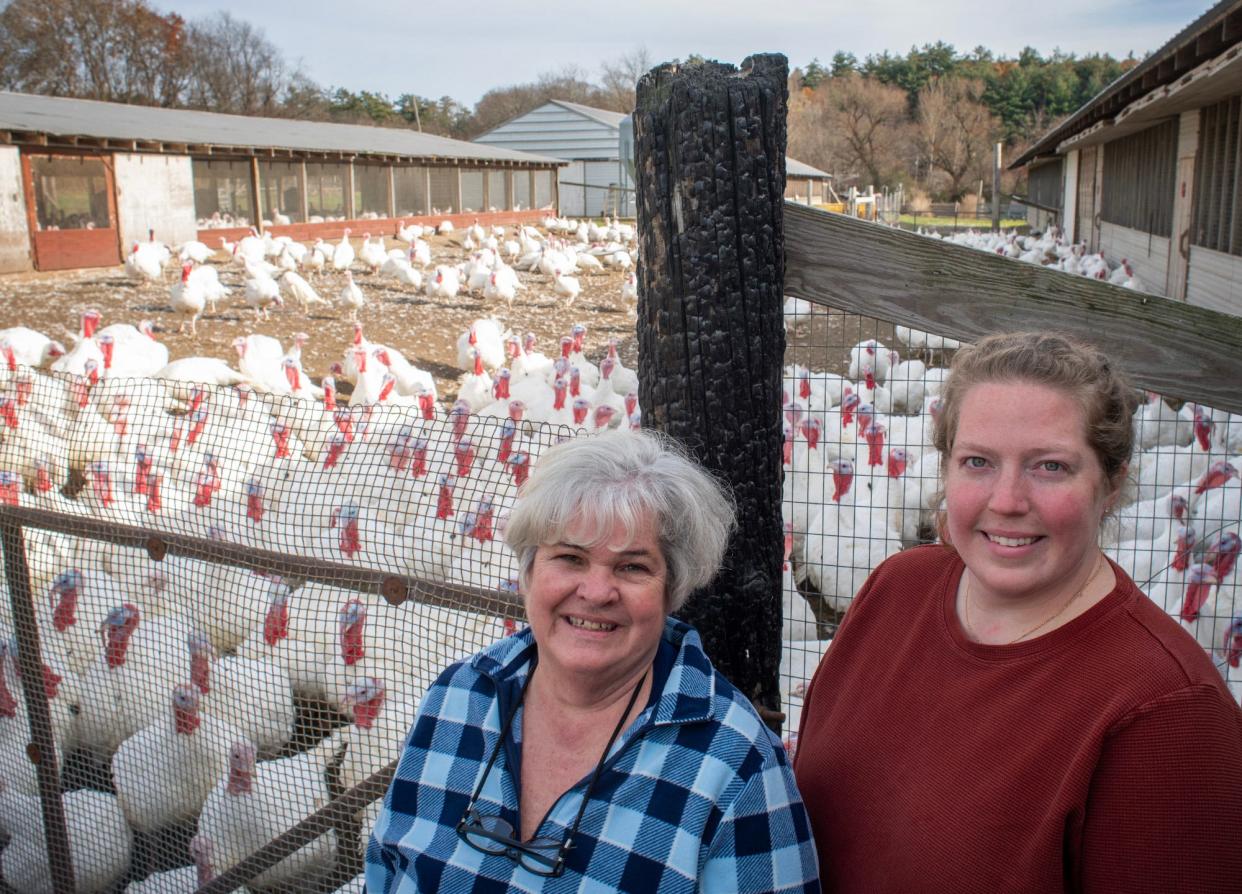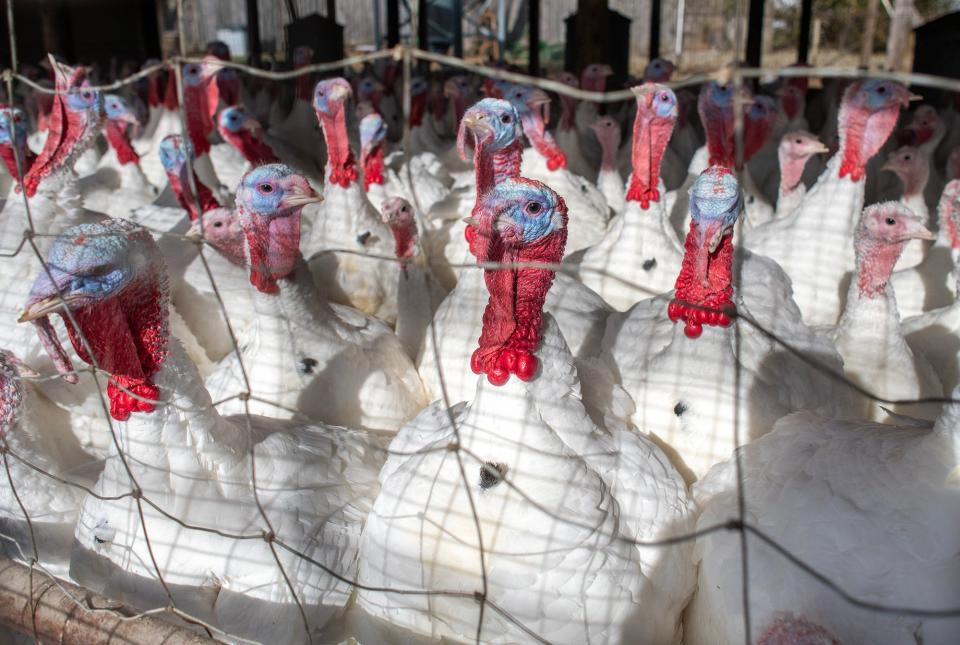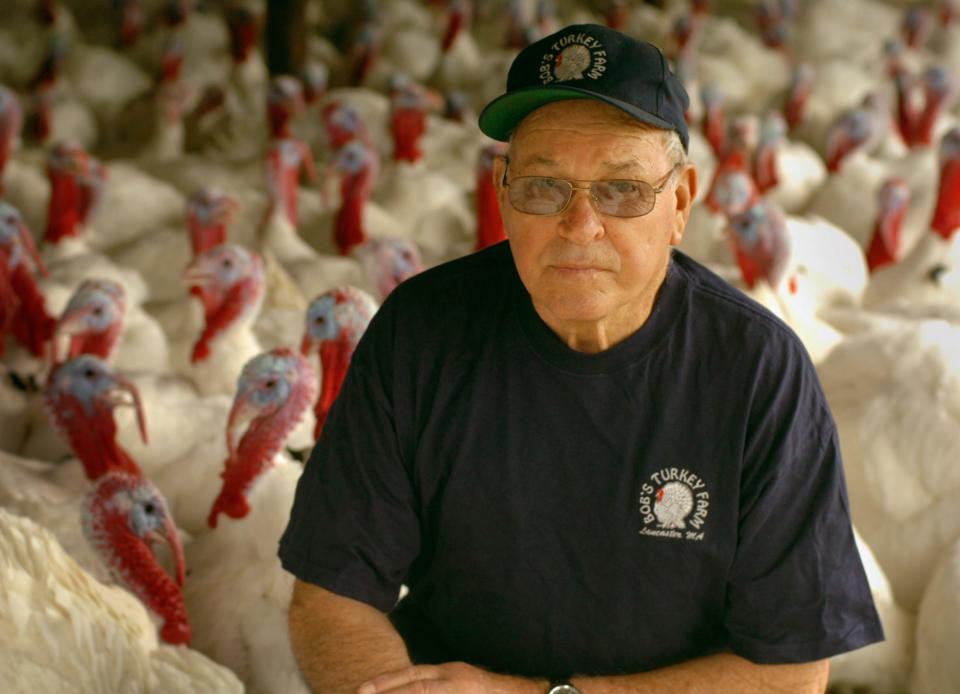At Bob's Turkey Farm, the gobbling is getting a bit more intense

LANCASTER – The gurgles of turkeys drown out the words of Susan and Jennifer Miner, the mother-daughter duo who run Bob’s Turkey Farm, as they stand in front of the gridded wires that keep thousands of turkeys within their roaming area.
Thousands of eyes stare through the wires, often becoming more imposing by the wattles hanging off the males' beaks.
Their white chests, marked by a tuft of black feathers at the center, typical for broad-breasted white turkeys, puff out as they let out yet another loud call.
“They react to familiar voices,” said Susan, who laughs after she’s cut off by an even louder wave of gobbles.
It was eight days before Thanksgiving, part of the busiest two-week window for the farm, the buildup to the holiday that Jennifer refers to as the farm's Super Bowl.
Lines to pick up turkey orders fill the parking lot to the point that a police detail is needed to direct traffic.
“If we were accountants, this would be our tax season,” said Susan with a smile.
Some customers, Jennifer said, discouraged by the long lines, will give up and look for another way of getting a turkey, often resorting to a store-bought one. The first orders at Bob's start trickling in about mid-September.

Turkeys left behind
In a year, the farm sells about 8,500 turkeys, mostly in the two weeks before Thanksgiving.
Last year, there were about 200 ordered turkeys that weren’t claimed. Something similar is expected this year, according to the Miners.
“I think they forget that they ordered them or their family plan changes and then they just don't cancel it,” said Jennifer. “Some people probably see the lines and turn around because it's insane.”
Susan said the most humane way to do it, put simply, is that the farm’s 12 workers stun the turkeys one by one using electric shocks.
Another wave of gurgling rings through the air, which, closer to the barns, is thick with the heavy pong of poultry.
2016 farm fire
The wires that define the area where the farm’s turkeys roam about are held together by wooden posts, typically as high as 7 feet.
Visibly charred from the June 2016 fire that claimed one of the four barns, one such post remains; it is still sturdy enough for the family to trust it with the duty of holding any turkeys from trying to make a run for it.
The post is the only visual reminder of the fire that started when one of the brooders — containers with a flame under them, used to keep the young chicks away from the cold — tipped over. One of its supporting chains had not been securely locked.
The flame set ablaze the wood shavings lining the barn floor for animal bedding, starting a chain reaction that burned down the whole structure, killing 7,000 turkeys, among them 2,600 chicks that had hatched earlier the same day.
“Sad part is, we had brooders from the 1960s,” said Susan. “It wasn't any of them. It was a brand-new one that I had just bought.”
Seven years on, despite the great devastation that rendered that year’s Thanksgiving season a significant challenge, Susan said the effect of the fire is no longer felt, punctuating that sentiment with a confident shake of the head.
The 150-foot-by-50-foot wood-framed barn that now stands over the same plot of land as the old one was back up a month after the fire, thanks in part to help from the surrounding community.
The Miners said help included financial support through a GoFundMe account and neighboring farms lending equipment to move the debris.
Jennifer did not share rebuilding costs, but she added the amount was “substantial,” more than they could afford even with the financial help of the community that aimed to cover the dues.
“We’re very thankful,” said Jennifer.
Susan said COVID-19 has had an even more challenging effect on the farm, citing staffing issues.
The 13,000 turkeys that the farm once raised has become a strange number that aligns only with the farm's past for the Miners. Forget about the more distant-sounding 20,000, the farm’s output in its heyday, when Susan’s father and founder, Robert Van Hoof, led operations.
“Every January, my brother and I will sit down and say, ‘What are we going to do this year?’” said Susan. “We’ve been slowing down. We might cut down a little more this year. We cut down last year and this coming year we might cut down some more.
“It is difficult getting enough help.”

A longtime source for turkeys
Van Hoof started the farm in 1954 with 125 turkeys.
After he died in 2018 at 90, Susan and Richard stepped in, although they had already been part of the business as early as 8 years old, bagging turkeys for the farm’s many orders.
The Miners praise Susan's brother, Richard Van Hoof, as the “backbone” of the farm, crediting him with doing all the real hard work, from breeding to hatching to slaughter.
The 70-year-old, who is about the same age as the farm itself, was reluctant to speak about his experience, just how the Miners had foreseen before the visit. It was yet another busy day for him.
In a quick exchange, when told about the appreciation that his sister and niece have for his work, he reacted with a humble wave, a respectful smile and an “Alright, I have to go round up some people and get started …” which faded into an unfinished sentence disappearing in the cold air of November.
“He works,” said Susan, firmly. “He's here at 4:30 in the morning for the full two weeks.
“It’s difficult for him without the right help.”
Susan and Jennifer echo each other as almost in unison they say, “We’ve tried.”
The farm currently employs 12 people — four of whom work in the kitchen, which is half the number from before the pandemic.
The kitchen is the venue where the turkeys are packaged.
From the kitchen also comes the sides of turkey gizzards, stuffing, hearts and livers, which they sell year-round out of their storefront.
“It’s hard work,” said Susan. “This is not like sitting at a computer.
“You’re working year-round, every day.”
Jennifer, who is often at the front desk, either taking calls or connecting customers with their turkeys, tells a story similar to her mother and uncle.
She said she was in middle school when she started at the farm. As time went by, she became more involved.
The 32-year-old works part time for the town of New Boston, New Hampshire, where she lives with her husband and two children.
On the days she doesn’t work for the town, she makes the hour-plus drive the rest of the days to be at the front desk, answering phones for the orders that come in and doing what is needed to place the farm in the eyes of the online consumer.
Family business
"It’s generations of dedication,” said Jennifer. “It’s always funny to me how people don't talk to their family. I grew up around my family.
“People are always like, ‘I don't know how you work with your mother,’ and some days I don't know how I work with my mother.
“When you have a common goal like this it’s really easy.”
As she says that, another wave of turkey gobbles, a staple of the Lancaster farm, rings through the air.
This article originally appeared on Telegram & Gazette: Bob's Turkey Farm in Lancaster ready for Thanksgiving rush

